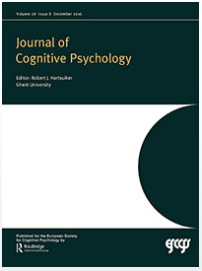吉川教授の共著論文が『Journal of Cognitive Psychology』に掲載されました
布井雅人聖泉大学講師と吉川左紀子教授の共著論文が、学術誌『Journal of Cognitive Psychology』Vol.28に掲載されました。
本研究は、図形の好み判断が、図形に対する知覚頻度と処理の深さによってどのように影響を受けるかを調べたものです。好み判断は、知覚頻度が増えるほど好意度が上昇することが知られています(「単純接触効果」)。浅い処理(位置判断)と深い処理(連想判断)の後の好み判断の評定値を比較したところ、深い処理をしたほうが好意度が上昇し、6週間後でもその効果は消えないことが分かりました。
 Masato Nunoi & Sakiko Yoshikawa (2016). Deep processing makes stimuli more prefereable over long duration. Journal of Cognitive Psychology, 28, 756-763
Masato Nunoi & Sakiko Yoshikawa (2016). Deep processing makes stimuli more prefereable over long duration. Journal of Cognitive Psychology, 28, 756-763http://dx.doi.org/10.1080/20445911.2016.1189917 ※認証有り
●ABSTRACT
The purpose of the current study was twofold. First, we investigated whether the type of stimulus processing (e.g. levels of processing) influenced preferences for novel objects. Second, we examined whether the influence of levels of processing on preferences was long lasting (e.g. longer than a day/week). Results showed that levels of processing affected preferences whereby more deeply processed stimuli were preferred over those that were shallowly processed. This effect was more robust for stimuli that were presented multiple times. Additionally, this levels of processing effect lasted for up to 6 weeks, suggesting stability in preferences for information that was more deeply processed. We discuss these results in terms of theories predicting the role of stimulus properties and exposure on the development of preferences.
KEYWORDS: Preference, levels of processing, delay
2016/12/05